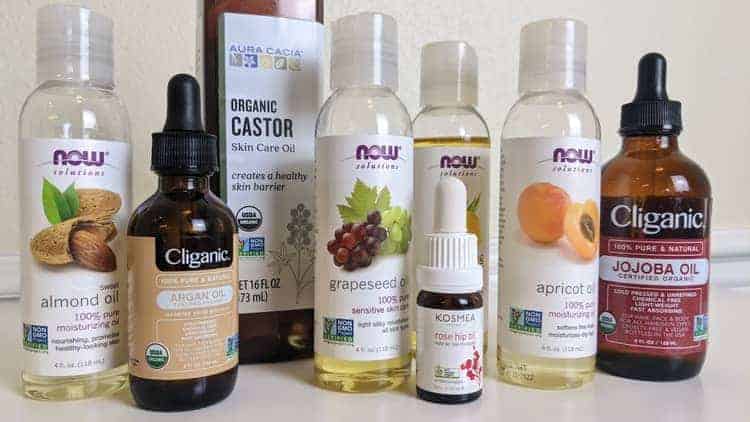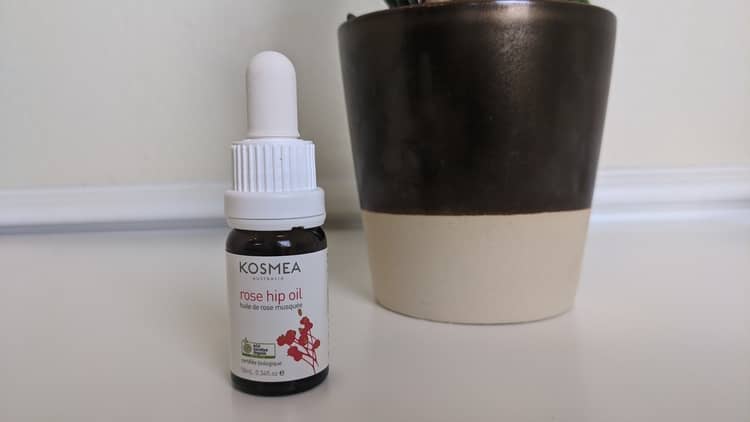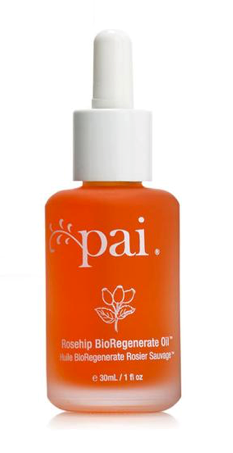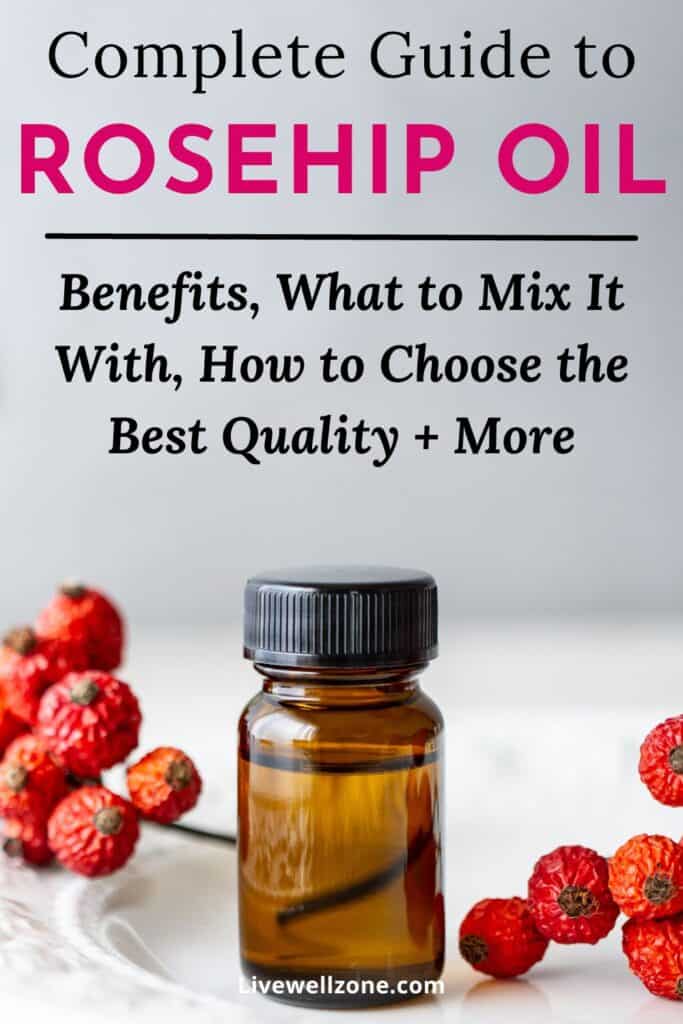
Like most carrier oils, rosehip oil contains fatty acids and vitamin E that are, in their own right, great for the skin. But even better, rosehip oil contains beta-carotene (provitamin A), which makes it stand out from other oils. However, before you run out and buy a random rosehip oil, use this guide on rosehip oil for skin to learn:
- the many benefits of rosehip oil for skin.
- the differences between rosehip oil and rosehip seed oil.
- how to choose a good quality rosehip oil.
- what you can mix with rosehip oil.
- how to add it to your skincare routine.
- the best rosehip oil brands.
Note: this post contains some affiliate links and I earn a commission (at no additional cost to you) if you use them to make a purchase.
BENEFITS OF ROSEHIP OIL FOR SKIN: HYPERPIGMENTATION, ACNE, PREGNANCY, SKIN BARRIER + MORE

Non comedogenic: rosehip oil is lightweight and fast-absorbing. Because it’s well absorbed and doesn’t just sit on the skin, it’s less likely to clog pores.
Supports healthy skin barrier function: rosehip oil is a rich source of the fatty acid, linoleic acid (about 54%). Linoleic acid is the most abundant fatty acid in the skin’s outer layer. Not having sufficient amounts of this fatty acid can lead to a compromised skin barrier, subsequently contributing to dryness, redness, itching, rough skin, fine lines, rashes and acne (source).
Beneficial for acne: some studies indicate that the sebum-produced by acne-prone skin is very high in oleic acid and very low in linoleic acid. So, using an ingredient like rosehip oil – which contains linoleic acid – may help to balance the composition of sebum and improve breakouts.
Rich in provitamin A: rosehip oil contains plenty of beta-carotene, which is converted to retinyl esters or preformed vitamin A (source). This vitamin A supports cell renewal and supports the production of collagen. In addition, that preformed vitamin A is the same group of compounds that retinol is in (which is why some people use rosehip oil as a natural alternative to retinol).
Anti-aging: because of its ability to support collagen production and encourage skin renewal, rosehip oil is ideal for aging skin. In addition, it’s ability to support skin barrier function makes it ideal for mature skin (which tends to be dry).
Locks in moisture: rosehip oil has occlusive properties that help to prevent moisture loss from the skin. It actually works best when applied to slightly damp skin because it acts as a sealant.
Natural remedy for hyperpigmentation, stretch marks and scars: anything that helps with skin turnover is generally helpful for skin discoloration, scars and stretch marks. So, it’s no surprise that rosehip oil is a popular remedy for all three of these skin conditions.
May Be Suitable for pregnancy: according to some rosehip manufacturers and dermatologists, rosehip oil can be used during pregnancy because it doesn’t contain retinol. Rather, rosehip contains beta-carotene that the body converts to a usable form of vitamin A (1, 2, 3).
THE DIFFERENCE BETWEEN ROSEHIP OIL AND ROSEHIP SEED OIL

Even though the terms rosehip oil and rosehip seed oil are used interchangeably, they can mean very different things. The term “rosehip oil” can refer to oil that is pressed from the entire rosehip fruit (seed, pulp and skin) while the term “rosehip seed oil” can refer to oil that is pressed from the seed only.
Unfortunately, there is no industry standard when it comes to how these two terms are used.
So, how do you know what’s actually in a bottle of rosehip oil? You can either:
- read the ingredients on the back label to see if it specifies which part of the rosehip was used.
- visit the company’s website to get details on how the product is made.
- email the company’s customer support team. I’ve found that companies are very responsive and more than happy to give you this information.
While it may seem like too much headache to get this information, here’s why it’s worth it: the rosehip seed contains mainly fatty acids, while the skin contains most of the beta-carotene (which the body eventually converts to preformed vitamin A).
So, being clear on what you’re getting in each bottle matters because the nutritional composition can vary.
WHAT TO LOOK FOR WHEN BUYING ROSEHIP OIL

The main things to look for when buying rosehip oil are:
- Type: check the label (or the company website) to see if the oil is a seed-only oil or a full spectrum rosehip oil (seed, pulp and skin). Both are beneficial for the skin, but knowing which part of the rosehip was used for the oil simply helps you to know which nutrients are in the oil.
- Extraction Method: The most common extraction method for oils is cold pressing. This method uses low temperatures to help preserve the nutrients in the oil. Another extraction method that some companies use is CO2 extraction. This relies on pressure from carbon dioxide and is very gentle, producing a very fine quality oil.
- Rose type: rosehip oil is made from wild roses which are different from the roses we use in a flower bouquet. Rosa canina and rosa mosqueta (aka rosa rubiginosa) are the two types that you are likely to see listed on a rosehip oil bottle. But that said, there are other varieties. So, depending on the region of the world that a company sources their plants from, you might see another type of rosa listed.
- Color and Smell: good quality rosehip oil has a reddish color, but it can also lean towards orange. As for the smell, my experience is that the seed-only oil can have a bit of a fish-like smell. On the other hand, the full spectrum oil that uses the seed and fruit has a pleasant, musk scent. NOTE: it should not smell like roses. If it does, then fragrance has been added to it.
- Packaging: a dark, glass bottle is best because it protects the rosehip oil from exposure to light. Avoid clear bottles (unless it clearly states that the bottle has a UV-protectant layer).
WHAT TO MIX WITH ROSEHIP OIL (AND WHAT TO AVOID)

Rosehip oil can generally be used with the following:
| INGREDIENT | HOW TO MIX |
|---|---|
| Aloe vera | Use in a blend with rosehip or layer (aloe first, then rosehip oil) |
| Carrier oils | Make a face oil with oils like jojoba, grapeseed, argan and more. This collection of DIY facial oil recipes has blends that you can make with just a handful of ingredients. |
| Clays | Add a few drops into a clay mask to reduce the mask’s drying effect. |
| Essential oils | Combine with tea tree oil or geranium oil (for acne), with helichrysum or frankincense (for wrinkles) or with mandarin oil for stretch marks. You can get recipes in this article on best oils for acne prone skin and this one on how to make stretch mark cream and oil. |
| Foundation | Blend rosehip and foundation, the |
| Hyaluronic acid | Apply after rosehip oil. |
| Moisturizer | For water-based moisturizer, apply moisturizer followed by rosehip. For moisturizers with lots of oils/butters, apply rosehip followed by moisturizer. |
| Niacinamide | Layer rosehip on top. |
| Vitamin C serum | Apply before rosehip oil. |
| Vitamin E oil | Mix both in a face oil blend. |
When it comes to things that you might want to avoid mixing with rosehip oil, it’s mainly retinol and hydroxy acids. For these ingredients, consider using them on separate days, rather than trying to layer them. This is particularly relevant for sensitive skin, which might be easily irritated by the combination of pre-formed vitamin A and these stronger actives.
For a more detailed look at all of the above items and how they work with rosehip oil, be sure to read this detailed guide on what to mix (and not) with rosehip oil.
BEST ROSEHIP OILS FOR FACE
There’s no shortage of rosehip oil on the market! However, this shortlist is meant to give you a selection of oils that are made through different extraction methods, using different parts of the rosehip and with various prices for every budget.
1. TOP PICK: Kosmea Rosehip Oil

- My personal favorite rosehip oil because it is CO2 extracted and made from the seed, pulp and skin.
- Organic certification.
- Very lightweight and absorbs really well.
- Very pleasant, musk-like smell.
- Works well on its own or in blends with other oils.
2. Rosehip BioRegenerate Oil

- CO2 extracted oil.
- Made from the entire rosehip (seed, skin and pulp).
- Certified organic, vegan and cruelty-free.
- contains vitamin E, rosemary leaf extract, squalene (vegan sourced emollient) and beta-sitosterol (fatty acid that moisturizes and soothes the skin) (source).
Get the Rosehip BioRegenerate Oil here.
3. Radha Rosehip Oil
- Cold pressed oil.
- Made from the seed.
- Certified organic.
- My experience with this one is that it has a fishy smell. But the smell completely disappears once you apply it on your skin.
4. The Ordinary Rosehip Oil
- Cold pressed oil.
- Made from rosehip seed.
- Very budget-friendly pricing.
Get The Ordinary’s rosehip oil here.
ROSEHIP OIL DISADVANTAGES AND SIDE EFFECTS
Rosehip oil is generally considered safe for topical use. However, if you have an allergy to rosehips in any form, then you’ll want to stay away from the oil.
Some forum users – such as on Reddit – also report getting breakouts or worsening of acne shortly after adding rosehip oil to their skincare routine.
This isn’t very surprising since no oil works for everyone. So, if you develop more breakouts or a rash when you start using this oil, discontinue it and try a different carrier oil.
FAQs ABOUT ROSEHIP OIL
Does rosehip oil contain vitamin C?
Even though the rosehip skin is rich in vitamin C, rosehip oil does not have vitamin C. This is because vitamin C is water-soluble, and hence cannot exist in an oil-based medium.
I have been able to validate this by sending email enquiries to two companies: Kosmea and Pai. Both of them make rosehip oil that includes the pulp and skin. And they both made it clear that there is no vitamin C in their rosehip oils. You can read their response in this article on essential and carrier oils that are rich in vitamin C.
Can I use rosehip oil directly on my face? (It is often diluted with other oils at 10%)
Rosehip oil can be used directly on your face. However, when it’s used in a blend with other carrier oils, it’s often used at a low concentration (about 10% according to some wholesale suppliers of cosmetics ingredients).
Can I use rosehip oil everyday?
As with other carrier oils, rosehip oil can be used every day, either by itself or in a face oil blend.
Should rosehip oil smell like fish?
Some rosehip oil can have a fish-like smell, even when it’s in good condition. To be sure that the smell is natural and not the result of rancidity or adulteration, make sure to get your rosehip oil from reliable brands. Go for quality, not just price.
How long does rosehip oil take to work?
Depending on what you’re using it for, rosehip oil can start to show results within a few weeks. For example, some people see improvements in acne within 4 weeks, scarring within 6 weeks and wrinkles within 6 weeks (source).
Why is my rosehip oil clear?
If your rosehip oil is clear, then it’s either been refined or adulterated in some way. Real rosehip oil will have more of a reddish or orange tint, not clear.
Is rosehip oil good for lips?
Rosehip oil can be used as a nourishing lip oil to keep the surface soft and supple. Just apply a drop to your lips whenever they feel dry. In addition, because rosehip oil helps with discoloration, it can also help to balance uneven skin tone on the lips.
TIP: make a soothing lip balm with shea butter, coconut oil, beeswax and rosehip oil!
Does rosehip oil help grow eyelashes? Can rosehip oil grow eyebrows?
There is no research pointing specifically to rosehip oil being able to grow eyelashes. But there are comments on some online forums from people saying that their eyelashes grew when they added rosehip oil to their skincare routine.
Can rosehip oil go bad and how do you know if rosehip oil is rancid?
Once opened, rosehip oil has a shelf life of about 6 months. Some rosehip oils can have a bit of fish-like smell, even when they’re “fresh.” As the oil goes bad, that smell can intensify and be more off-putting. Also, note that as the oil goes bad, the color can also change from its original state.
Is retinol better than rosehip oil?
Retinol contains synthetic retinoid that is converted to the active retinoic acid. On the other hand, rosehip oil contains trace amounts of retinoic acid, along with fatty acids, beta carotene (which is converted to preformed vitamin A) and vitamin E. The choice of which one is better boils down to what your skin needs and your personal preference.
So, if you want a source of retinoids and don’t mind using something synthetic, then retinol is for you. On the other hand, if you prefer natural ingredients and want your skin to benefit from multiple nourishing ingredients, then rosehip oil is a better option for you.
CONCLUSION
Rosehip oil is a multi-purpose carrier oil that can be used on the face and body. This versatile oil works well on its own or as part of a face oil serum.
Whichever way you choose to use it, I hope that this article has given you clarity on its benefits, how to use it and how to choose a high quality rosehip oil!

You Might Also Enjoy:
Rose Oil vs Rosehip Oil for Skin And Hair: Benefits | Which is Better | How To Use
Rosehip Oil vs Hyaluronic Acid: Benefits, Differences & How To Use Them
Carrier Oils By Skin Type: How to Choose and Simple List for Beginners
Why You Need Rosehip Oil For Hyperpigmentation (& How To Use)
Best Natural Alternatives to Retinol: 8 Vitamin A Options You Might Be Ignoring
Vitamin C Serum vs Rosehip Oil: Benefits, Which Is Better and How To Use
The Difference Between Rosehip Oil and Rosehip Seed Oil: Benefits, Which To Use and How to Use
How To Choose The Best Rosehip Oil: 5 Things to Look For (and Recommended Brands)
How To Add Rosehip Oil To Your Skin Care Routine: In-Depth Guide
Sea Buckthorn Oil vs Rosehip Oil: Benefits, Which is Better and How to Use

